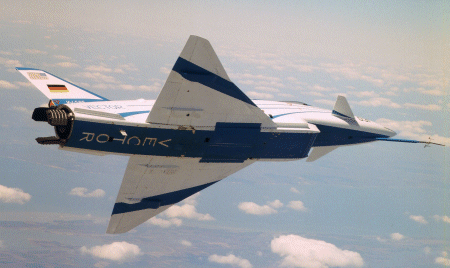STEWART PENNEY / NAS PATUXENT RIVER
First two phases of the VECTOR flight test programme are covered, but there is no money for the third element
The US Navy is seeking additional funding for the X-31 Vector (vectoring extremely short take-off and landing and tailless operational research) programme due to delays in returning the highly manoeuvrable aircraft to the air after a six-year lay up. The navy is leading a team involving Boeing, EADS and the German ministry of defence in a project to demonstrate extremely short take-off and landing (ESTOL) operations.

Jennifer Young, USN X-31 Vector programme manager, says some components were no longer serviceable following the aircraft's lay-up and delays resulted because of the difficulty in securing replacement parts, particularly as some are no longer manufactured.
She says the existing budget will not cover the test programme and a request has been made for additional funding. It is, however, too early to say how much will be required, adds Young.
The $60 million contributed by the participants is enough to cover the first two phases of the flight test programme, but the third element will need more money.
Vector aims to demonstrate the use of a very high angle of attack (AoA) during the approach to landing, for ESTOL operations. This would mean a 30-40% reduction in landing speed. The programme is also testing an EADS flush air data system that fits in the tip of the nose cone and measures static and dynamic air pressure as well as AoA and angle of sideslip without the use of external vanes.
The first phase of the work covered 10 flights over 7.2h in April to evaluate the aircraft after its return to airworthiness. It is now being modified at the USN's test centre at NAS Patuxent River, Maryland, for second phase trials. This includes approaches to a "virtual runway" at 5,000ft (1,500m) altitude, and at up to 40í AoA. The aircraft automatically pitches up to the required AoA before "de-rotating" close to the ground just before the wheels touch the ground. The pilot acts as a monitor only during the approach and does not take control until the X-31 is on the runway.
First flights of the X-31 after rebuild are due in the early fourth quarter of this year and will last until April 2002. The aircraft will then be modified with the miniaturised, EADS air data system.
Third phase testing includes trials of the automatic approach system to a real runway.
Meanwhile, the Spanish defence ministry is continuing to discuss a foreign military sale that would see the X-31 equipped with a Eurojet EJ200 fitted with a thrust-vectoring nozzle developed by ITP in place of the General Electric F404 and thrust vectoring paddles.
Source: Flight International



















